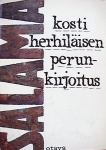Sounds of Seoul Marketplaces: Gwangjang Market
 Below I had a note on the availability of six snippets from the DVD "Sounds of Seoul Marketplaces" at the Visual Anthropology Archive. Below I had a note on the availability of six snippets from the DVD "Sounds of Seoul Marketplaces" at the Visual Anthropology Archive.The snippet one (click the captured screenshot) is of Gwangjang Market, adjacent to Dongdaemun Market between Jongno 5-ga and Cheonggyecheon. It used to be and to some extent still is a marketplace for clothing material and clothes, especially tradition ones (hanbok). Now that the everyday use of traditional-style clothing has dwindled since long, Gwangjang Market has had to adjust to that. In this case, the talk of the two merchants interviewed in the video about how business used to be so good earlier should not be just the ordinary businesskeeper discourse. The gentleman in the screenshot gives some interesting pieces of info concerning trading practices. In the capture he is explaining the numbers in the secret jargon of the traders: kôn, ch'a, yô, chông, in, kyo, paek, t'ae, u, nogang; nogang is (was?) used also for hundred, thousand, and ten thousand. A customer who seemed to have a lot of money is yônach'i, a good customer, and someone who seemed to be picky (kkankkanhada) and not likely to use money was ssebong. Someone coming to buy marriage goods (honsu) was ûldongi, and the buyer of 60th birthday (hwan'gap) paraphernalia was kaptongi. (Ûl and kap; does that mean that the latter, hwan'gap customers were better that honsu customers, that is, better in using money? Or did the two terms just got attached to the two kinds of important customers since they are a traditionally attached pair?) For the 7-minute Gwangjang Market video, click the captured picture. Categories at del.icio.us/hunjang: marketplaces ∙ anthropology ∙ Koreanstudies ∙ Seoul ∙ Koreanlanguage |


Comments to note "Sounds of Seoul Marketplaces: Gwangjang Market" (Comments to posts older than 14 days are moderated)
Write a Comment